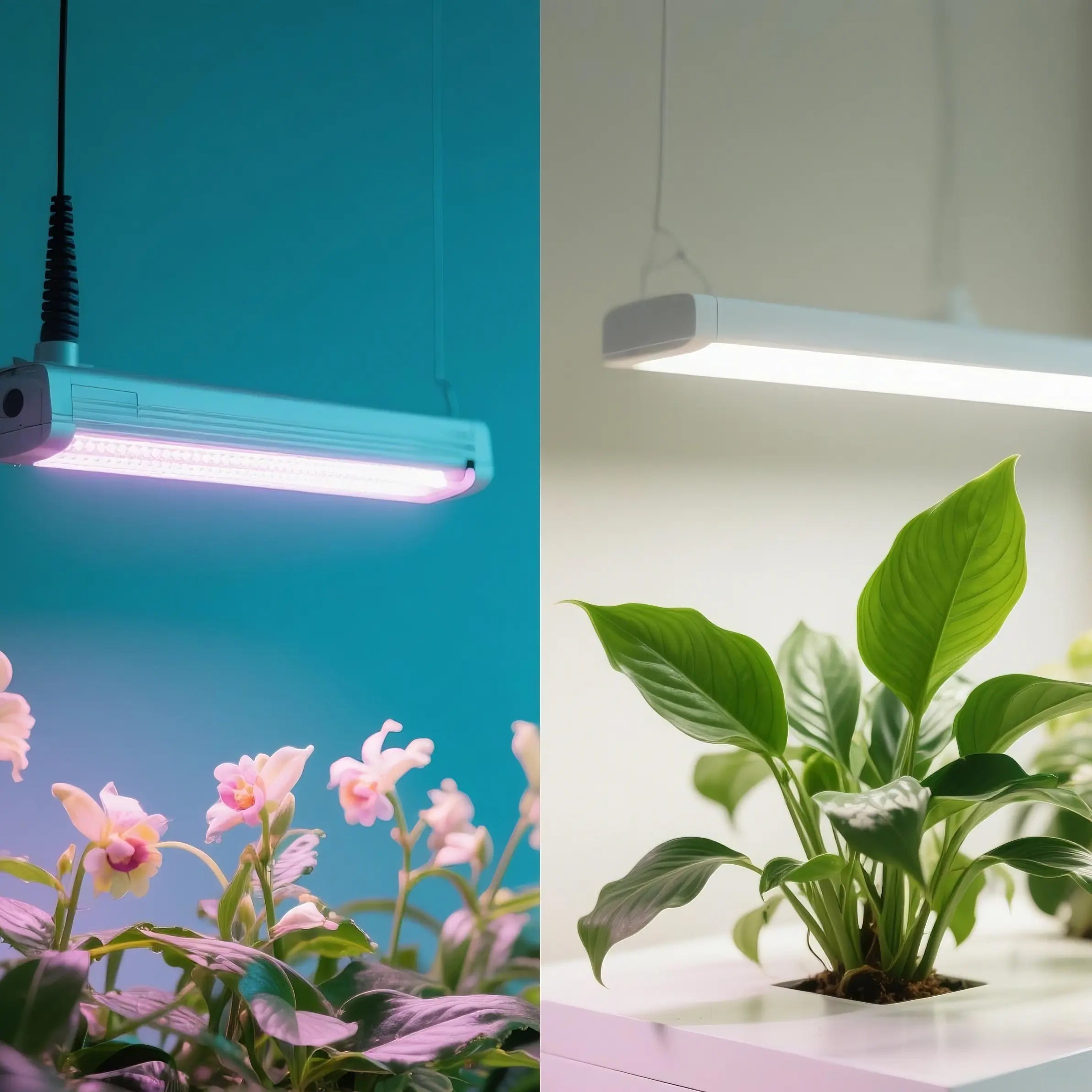Indoor-Gartenbau und kommerzieller Gartenbau erfreuen sich wachsender Beliebtheit, und die Beleuchtung ist das Herzstück dieser Revolution. Während herkömmliche LED-Leuchten energieeffizient und weit verbreitet sind, LED-Wachstumslichter sind speziell dafür entwickelt, Sonnenlicht für das Pflanzenwachstum zu imitieren und zu optimieren. Wir erläutern die wichtigsten Unterschiede anhand wissenschaftlicher und praktischer Erkenntnisse, um Ihnen bei der Auswahl der richtigen Beleuchtung für Ihre grünen Begleiter zu helfen.
1. Spektrum: Der Kernunterschied
Wachstumslichter :
- Senden Sie ein Vollspektrum (400–700 nm) auf die Photosynthese zugeschnitten, einschließlich Rot (600–700 nm) für Blüte/Fruchtbildung und Blau (400–500 nm) für Blattwachstum und Energieabsorption .
- Erweiterte Modelle integrieren Infrarot (IR) Und Ultraviolett (UV) Wellenlängen zur Verbesserung der Nährstoffdichte, der Pathogenresistenz und der Stresstoleranz .
- Beispiel: Ein Spektrum aus 70 % Rot und 30 % Blau steigert die Biomasse von Salat unter kontrollierten Photoperioden um 30 % .
Normale LEDs :
- Für das menschliche Auge konzipiert, emittiert weißes Licht (2700K–6500K) mit Lücken in kritischen roten/blauen Wellenlängen .
- Fehlende Anpassung an die Wachstumsstadien der Pflanzen, was zu Wachstumsstörungen oder langbeinigen Stängeln führt .
2. Lichtintensität und Effizienz
Wachstumslichter :
- Messen Sie die Ausgabe in PPFD (photosynthetische Photonenflussdichte), die eine optimale Lichtintensität gewährleistet (50–120 μmol/m²/s für die meisten Pflanzen) .
- Liefern 3–5x höhere Effizienz als Glühlampen und 60 % Energieeinsparung gegenüber HPS-Lampen .
- Beispiel: Hochintensives blaues Licht (75 μmol/m²/s) verhindert spindelförmiges Wachstum bei Tomaten und Chrysanthemen .
Normale LEDs :
- Priorisieren Sie Lumen (Helligkeit für Menschen), da die PPFD-Anforderungen für dichtes Laub oder Blüten oft nicht erfüllt werden .
- Verschwenden Sie 98 % der Energie als Wärme oder nicht-photosynthetische Wellenlängen .
3. Wärmemanagement und Lebensdauer
Wachstumslichter :
- Produzieren minimale Hitze , ermöglicht eine dichte Platzierung, ohne dass die Pflanzen verbrennen .
- Zuletzt 50.000–100.000+ Stunden (im Vergleich zu 15.000 Stunden bei herkömmlichen LEDs) aufgrund des robusten thermischen Designs und der geringen Degradation .
Normale LEDs :
- Geben im Verhältnis zum nutzbaren Licht mehr Wärme ab, sodass bei zu geringer Platzierung die Gefahr von Blattverbrennungen besteht .
- Kürzere Lebensdauer bei Dauerbetrieb (z. B. 16-Stunden-Tageszyklen) .
4. Anpassung und intelligente Funktionen
Wachstumslichter :
- Angebot dimmbare Einstellungen , 0–10-V-Steuerung und IoT-Integration zur Anpassung von Spektren und Intensität für Setzlinge, vegetatives Wachstum oder Blüte .
- Unterstützt Daisy-Chaining für skalierbare Setups (z. B. vertikale Farmen) .
Normale LEDs :
- Feste Spektren und Intensitäten, wodurch die Anpassungsfähigkeit an die Bedürfnisse der Pflanzen eingeschränkt wird .
5. Kosten und Nachhaltigkeit
Wachstumslichter :
- Höhere Vorlaufkosten (z. B. 500+ pro Einheit), sparen aber langfristig durch Energieeffizienz und weniger Austausch .
- Recycelbar und quecksilberfrei, im Einklang mit umweltfreundlichen Praktiken .
Normale LEDs :
- Anfangs erschwinglich, aber für ernsthafte Züchter ineffizient, da mehrere Glühbirnen erforderlich sind, um die Leistung einer einzelnen Wachstumslampe zu erreichen .
6. Anwendungen in der realen Welt
- Heimzüchter : Kompakte LED-Wachstumslampen (z. B. 30 W–60 W) sind ideal für Kräuter, Klone oder kleines Gemüse .
- Kommerzielle Farmen : Vollspektrum-LEDs erhöhen den Zuckergehalt von Erdbeeren um 20 % und die Blattgröße von Basilikum um 15 % .
- Vermeiden Sie herkömmliche LEDs für : Fruchtpflanzen (z. B. Tomaten), blühende Pflanzen oder lichtintensive Arten wie Cannabis .
Fazit: Warum Pflanzenlichter gewinnen
Während herkömmliche LEDs Pflanzen mit geringem Lichtbedarf (z. B. Sukkulenten) versorgen können, LED-Wachstumslichter sind unübertroffen in Bezug auf robustes Wachstum, höhere Erträge und nährstoffreiche Produkte. Sie ahmen die Wissenschaft des Sonnenlichts nach und bieten:
- Präzisionsspektren für die Photosynthese.
- Energieeinsparungen und Haltbarkeit.
- Anpassungsfähigkeit für alle Wachstumsstadien.
Für Hobbygärtner ist eine günstige Pflanzenlampe (z. B. eine 100-W-Vollspektrum-LED) eine lohnende Investition. Für Profis sind anpassbare Systeme mit Rot-/Blau-Dominanz und intelligenter Steuerung bahnbrechend. .
Letzter Tipp : Kombinieren Sie Ihre Lampen mit den richtigen Photoperioden (12–16 Stunden täglich) und Nährlösungen (EC 2,0–2,5 dS/m), um optimale Ergebnisse zu erzielen .
#IndoorGardening #LEDGrowLights #UrbanFarming #SmartAgriculture

